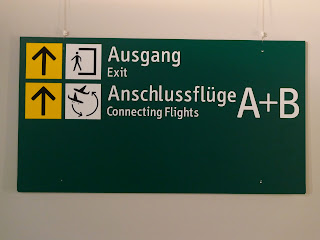 |
| Young and Old Olive Tree |
We fled the tourists and escaped to Crete’s White Mountains, known for their olive oil and honey production. I had pictured rural Greece to be a vista of soft, lush, rolling hills covered in olive orchards and vineyards. I had
not expected the hillsides a dusty brown and barren of trees. The reality is that the mountains are covered in gray-green shrubs. Every
single plant and leaf is encased in a cage of prickles.
 |
Spines
|
I would not want to be a goat in this ecosystem. From the car, the mountains slopes look fuzzy and soft. However, I found out through trial and error that brushing against a plant means certain wounds and marks of battle.
 |
| An Old Olive Orchard |
There is one exception to this rule of thorns: the olive groves. Olive trees are not thorny or covered in spines; instead they have incredibly tough leathery leaves and bark. Spines are the plants’ adaption to living with grazers and the tough waxy leaves are an adaption preventing dehydration in the harsh sun. On north facing slopes, especially in gullies, there is a profusion of trees, larger shrubs and greenery escaping the sun.
 |
| Old Walls |
Everyone says that a car is necessary to explore Crete properly. For us, the car means that we can meander through little mountain towns that would be inaccessible otherwise. These towns, often called something with too many syllables, have been there for centuries. The new houses blend with the old and often share exterior walls and lower stories. Some of the smaller towns look like they have looked forever: stone houses, narrow cobbled streets, and olive trees everywhere.
 |
| A Small Town |
“Town” is sometimes an exaggeration. There may be only a handful of houses per “town” and minimal to no infrastructure for tourists—which was exactly what we were looking for. The one common concession to tourism was the traditional tavernas, some more traditional than others. It seemed that we would stop and eat at each town we drove through. At one taverna, we were taken care of by a group of Greek grandmothers; and grandfathers—who spoke no English. We thought we had ordered four small
Calistunia (sweet cheese pastries) but instead got six each. They were delighted however that we were enjoying their food so enthusiastically so we had to finish everything. Georgie saved the day and ate most of my mum and dad’s portions. Then we (yes, all of us) were given the customary
raki (Cretan hard liquor) and fresh figs and grapes (yum). By the end of our time in Crete, my mum and I had become rather fond of the
raki, especially when mixed with large quantities of honey--
rakomelo. My dad however liked
raki right from the start.
As we were leaving the taverna, my mum dashed back inside to ask them an ethnobotanical question. It had been raining, and we had heard that the rain would make the grapes explode. So she asked, in fluent Greek, “Rain bad grape?” Oh, the look we got was priceless. They all nodded their heads enthusiastically and acted like we had spoken great words of wisdom. Clearly, they don’t see much intelligent tourists.
From a cars view, the towns are set very close together. Usually only a mountain separates the towns, which is only a five minute drive. However, walking from village to village, carrying a load, would probably have taken 40 minutes to an hour. I think that perhaps our modern view of distances is skewed—we can travel 100km in an hour and around the world in a day. Distances that people would have made once in their life, if at all, we can drive in a relatively short amount of time.
 |
| A Variety of Jarred Food |
These mountain hamlets tend to be nestled against the north side of the mountains and along ravines. Spreading out from the towns are the ancient olive orchards. In some cases, the whole mountainside is covered in old and modern terraces filled with olive trees. It amazes me that these mountains have been manicured for centuries and that even in the most remote places there are no unaltered landscapes. Even the ecological reserves have goats grazing on them.
 |
| A Traditional Olive Press in a Wall |
Each family produces, and many sell to tourists, a variety of traditional food: honey (
meli), maramlades, olives, olive oil, wine, nuts,
raki, herbs, teas, juice concentrates and soap. Each town seems to sell different, and better, kinds of olive oil and prepared olives. My personal favorite combines these: olives cured in lemon olive oil. Today, each family brings their ripe olives (in January) to the town’s mechanized olive press. The ancient method of rolling an immense stone, and more recently concrete wheel across the olives is no longer used.
 |
| The View From the Mountains |
At the beginning of our Crete exploration, we were not optimistic about being able to fully immerse ourselves in Cretan culture. We don’t speak Greek, except for phrases like “old stone to push olives”. However, I feel like I have experienced the traditional culture of Crete. I saw mountains covered with olives, terraces, and other traditional forms of agriculture. In the little towns, I was able to interact with people who still distill their own
raki. Cretans are a warm, welcoming, and tough group of people who have learned to survive in one of the harshest landscapes I have ever seen.
However, driving through the mountains, we also saw abandoned farms and olive orchards. The alarming trend is that people are moving away from their farms towards the cities. While they can support themselves with agriculture, they don’t have enough disposable income for electronics and the other measures of success in modern society. Also, more and more Cretans are eating American food. One person we talked to on Crete, said that Cretans are eating fried potatoes three times a day and are dying of heart failure and obesity in their 60’s. I realized that the “traditional” Crete we, the tourists, want to see is becoming harder to find as the culture changes. I wonder how the new Cretan culture will develop.





















